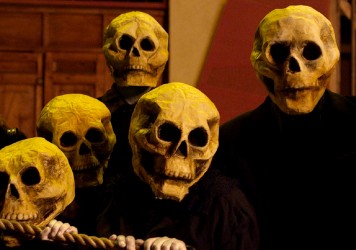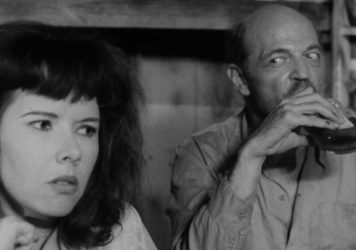
Two feuding brothers stand shirtless before one another in a room, their eyes closed in a trance-like state. Suddenly their mother appears and they all wrestle while the camera looms over. A depressed elderly woman – a migrant-hater who feels she’s wasted her life – begins a new daily routine, going each morning to water a nearby ficus tree. A singer songwriter with an absent father hammers randomly at his piano before stripping off his clothes to perform a strange burlesque dance. A man who hates his family takes a hammer and smashes pumpkins with each of their faces on, before sending the shards back home by DHL. A suicidal addict, a victim of child abuse, is buried alive on screen while carrion pick raw meat from around his head.
These are all examples of ‘pyschomagic’, a form of artistic therapy coined by the Chilean avant-garde director Alejandro Jodorowsky. This is something he’s written about for years and which has now, finally, been given dedicated screen-time in a crowdfunded documentary of the same name. The idea behind psychomagic is simple: that techniques from theatre, film, dance and other arts can be used to enhance the power of psychoanalysis.
While most therapy tends to involve speaking, and forbids physical contact, Jodorowsky’s proposal is explicitly, often excessively, tactile. Much of his focus is on “unlocking” childhood memory and overcoming shame associated with trauma. Some of the scenarios are funny, others are disturbing. All are absurd. And yet, Jodorowsky insists, he is an anti-surrealist. His purpose is not to represent the unconscious but to rebuild the world around it.
If nothing else this is a daring work of cinematography, and pays homage to the unique aesthetics the director pioneered in his early works, El Topo and The Holy Mountain (both of which are spliced into the edit). The chapters are short, offering tasters of each case, and each trauma. Just as we’re beginning to get under the skin of a certain character, we’re introduced to another. For the viewer, the fascination, and pleasure, is premised on the voyeuristic pleasure of watching people do silly things.
It’s exciting, poetic and to some extent cathartic. The idea, presumably, is that as we watch we begin to feel less ashamed of our own secret kinks and anxieties. And yet this isn’t a fiction film. Many of those on screen are really, desperately, in need. In one scene, Jodorowsky accompanies a woman on her first return visit to the tower block from which her husband threw himself to his death in the days following their wedding. The woman begins to weep, and when the director reaches out to hug her she is visibly uncomfortable.
Beyond shock value and provocative taboo-busting, it’s hard to say what this documentary accomplishes. If the idea is to prove that ‘psychomagic’ is an effective therapy, then the jury’s out. Only a few highly selective cases are shown to have provided long-term term benefits. Most of the clips are limited to the protagonists’ immediate reactions. The film treads on particularly dangerous ground in its penultimate scene, in which a woman is apparently relieved of cancer by a theatre of well-meaning people pushing ‘energy’ towards her.
The point is not to suggest that such rituals can be a replacement for chemo and radiotherapy, insists the director, but to make the woman feel strong, and to become a participant in her own healing. There may indeed be something in that. The fact that the chapter’s opening caption deploys the word “cure”, though, is naive at best, if not actively irresponsible.
The film ends with footage of thousands of people marching through the streets dressed in costumes of skeletons and zombies to celebrate Mexico’s Day of the Dead festivities. At a certain point Jodorowsky emerges from the crowd and encourages those around him to repeatedly chant, “psychomagic against violence”. Is this an innocent effort to fuse his own esoteric project into a broader social ritual? Or is the director appropriating this tradition, treating it – rather arrogantly – as an extension of his own brand?
However generous one’s interpretation, this moment exemplifies a fundamental tension that re-remerges throughout the film, between the autonomy of the subjects on camera and their selective framing by the magicians in the editing suite.
Published 20 Nov 2019

The mad Chilean maverick Alejandro Jodorowsky returns with his first film since 1990.

We’ve teamed up with the director of Drive and The Neon Demon to bring weird cinema to the masses.

A personal diary from a filmmaking workshop in Peru, hosted by the legendary German director.